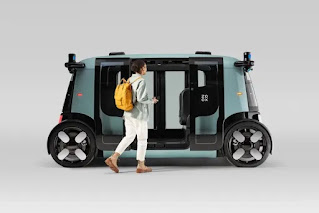While robotaxis still can't seem to exhibit its business case, robot shuttles are developing.
You can imagine how Europe can before long call a robotaxi in the event that you read a great deal of tech news. Sadly, this will be off base since those distributions are without a doubt examining drives in North America, and the EU takes a totally different position on independent ridesharing and ride-hailing than the US.
In this way, we possibly had to know when we could ride a robotaxi in Europe. For what reason can't we yet, then, at that point?
Robotaxis (and a couple of robot shuttles) are presently being used in the US, however, just roboshuttles are being used in Europe; these words will be characterized later. Guidelines and reasoning are the principal factors isolating the two districts.
However, we should make a stride back. What we mean via independent vehicles, robotaxis, and roboshuttles should be seen first.
Independent Driving Levels
Computerization in vehicles envelops undeniably more than oneself driving robot rides that many individuals imagine. The five levels of vehicle robotization are as per the following:
Levels 2 through 4 computerization are the focal point of the new venture flood in independent vehicles.
At Level 4, a vehicle can work independently in specific conditions. A Level 5 vehicle can ultimately work totally all alone. There aren't any such vehicles out and about at this moment.
How about we currently look at the differentiation between robotaxis and roboshuttles to more readily understand the reason why Europe lingers behind the US around here?
Robot shuttles vs. Robotaxis
There are two sorts of Level 4 independent individuals conveying vehicles on the streets when we discuss ride-hailing vehicles:
Robotaxis, which works at lawful paces and can move travelers anyplace inside a foreordained region in either a metropolitan or rural setting.
Roboshuttles (either transports or vehicles) travel along a foreordained course with a set start and finishing focus while moving substantially more leisurely on account of the transports.
All in all, a robotaxis can ship travelers anyplace inside a foreordained region, though a robot transport ventures to every part in a similar way. Presently, we should grasp what is happening in the independent market to understand the reason why we can't right now call a robotaxi in Europe.
These are the robotic vehicles that are currently available for use in the EU.
Each of the vehicles in the EU is roboshuttle-style. These vehicles need ordinary driving guides like directing haggle mirrors since they were planned to start from the earliest stage without them. On business and confidential property, and less significantly on open streets, they move all the more leisurely.
The primary contender is the French organization EasyMile, which was quick to give a totally independent 12-seater. While EasyMile works all through Europe, it is principally dynamic in France and Germany. Moreover dynamic on business premises is the French administrator Navya, while TalTech College in Estonia is directing examination by working a roboshuttle administration on its grounds.
The UK is small and just offers a couple of roboshuttle administrations on confidential property. One year from now, the geofenced public streets will see the arrangement of vehicles from the business' joint body Oxbotica and Sweden's NEVS, with additional European undertakings continuing in 2024.
Moreover, there is only one administrator who expects to give a taxi administration. Mobileye uncovered plans to work with auto rental organization Sixt SE to send off a vehicle in Germany in 2023 last year. From that point forward, nothing has occurred.
Generally speaking, Europe is totally different from the US, where there are various business robotaxi choices dynamic or being developed.
At present, two organizations in the US — GM-claimed Journey and Letter set possessed Waymo — offer paid Level 4 administrations in the way of cabs inside foreordained zones. These vehicles don't have drivers, and you can hold and pay for them very much like a normal taxi.
Moreover, there are other opponent administrations, (for example, Motional, MobilEye, Zoox, and Aurora) and an assortment of roboshuttle administrations that are endeavoring to get up to speed.
This leads us back to the first question: for what reason do Americans have robotaxis, while Europeans are restricted to roboshuttles? The response, be that as it may, is tracked down in the article's absolute first sentence: regulations and philosophies.
Guideline: US against. EU
While independent vehicles are directed at the state level in the US, where legislatures have the choice to completely embrace the innovation, traveler vehicles in the nation are expected to stick to Government Engine Vehicle Wellbeing Guidelines.
Ponder California. The biggest financial backers and IT organizations on the planet are now based there. Subsequently, organizations like Waymo and Journey can acquire a benefit by putting a long time developing connections with nearby government delegates, associations that advance street security, promotion gatherings, and town organizers.
In Europe, the situation is altogether unique since EU enrollment requires agreement among various countries.
I talked with NVIDIA's Barnaby Simkin to study how this functions more. He directs and applies impact over regulations and principles relating to computer-based intelligence mechanization and virtual testing as the group's administrative issues supervisor.
The trouble of "giving confidence to the business, empowering carmakers to show their security believability" is one that Simkin said the EU has been battling with.
Be that as it may, inside the Association, countries with a long history of auto creation, similar to Germany, are especially headed to upgrade vehicle mechanization.
What's more, apparently this is spreading. The Overall Security Guideline was endorsed by the EU in July. The principal authoritative system grants computerized and completely independent vehicles to be utilized on European streets. Individuals guess that its execution will expand advancement and raise the alliance's car industry's degree of rivalry.
Indeed, even while Europeans are taking a more conscious and mindful methodology, they are regardless working together across enterprises and leading joint Research and development.
What's more, this is the point at which the contention's philosophical part becomes an integral factor.
Recognizing what is beneath
There is an extra element adding to Europe's postponements, one irrelevant to rules, which makes sense of why we use roboshuttles as opposed to robotaxis. In reality, the US and Europe hold differentiating conclusions about how computerization should squeeze into the fate of transportation.
45% of Americans need admittance to public travel. Given the limitlessness of the country, it ought to shock no one that private vehicles are utilized essentially more much of the time than public transportation. Be that as it may, the numbers are as yet alarming. The US government declared its biggest-ever interest in open transportation in 2021, adding up to $108 billion.
Sounds gigantic, huh? Indeed, not when you consider that VCs put $80 billion in independent vehicles somewhere in the range of 2014 and 2017 - and, surprisingly, more since. Since there aren't an adequate number of interest in open transportation, most individuals drive their own vehicles. Urban communities view independent ride-hailing for the purpose of uprooting individuals from auto proprietorship subsequently.
While in Europe, organizations like EasyMile are allowed consent to fill in assistance holes in the public transportation framework. The business started offering help at the Belgian hotel of Terhills this year.
This try isn't "a proof of idea," as per the organization's Head of Key Drives, Traveler Transportation, Arwid Schmidt. Not a "show," by the same token. All things being equal, a "standard manned electric transport on the site" that wasn't utilized enough since they couldn't find the specialists were supplanted by a ten-year understanding. The course is presently being gone by five EasyMile independent modes of transport essentially on a more regular basis.
The organization coordinates its buses with public transportation schedules and tags in different urban communities in a way like this. Conversely, most administrators in the US (except for May Portability) give need financially beneficial courses over the fixing of administration holes.
Moreover, European ride-hailing organizations aren't racing to embrace independent vehicles, except for Sixt's assertion (about which we haven't heard anything since a year ago). The ongoing degree of security and administration quality, as per Cabify's CTO Carlos Herrera, is inadequate.
Notwithstanding, he guarantees that his association is continuously ready to consider any thought "for however long it is as per improving urban areas and improving their spots to live. On the whole, the objective should be to accomplish zero emanations immediately.
These organizations are focusing on hitting their fossil fuel byproduct objectives regardless of the ongoing monetary unconventionality. This expensive venture focuses on exchanging ICE armadas for EVs instead of financing the improvement of independent vehicle innovation. Once more, very unique in relation to the US.
Furthermore, presently we comprehend the reason why Europe hasn't taken on robotaxis yet: it has a superior created public transportation framework, really testing regulative necessities, and less confidential venture. However, is it actually an issue that there aren't a lot of independent vehicles on the mainland?
The benefits of Europe's cautious approach to robotaxis
The landmass' traditionalism is helpful since it has stayed away from the issue looked at by US administrators in moving from preliminaries to a serviceable strategy. To put it another way, being first suggests taking the greatest risks. Argo.ai, a robotaxi firm possessed by Passage, just shut down. Jim Farley, the Chief of Passage, said the accompanying on an income call:
"We keep on accepting that L4 innovation will fundamentally influence how individuals are moved," Notwithstanding, he added that creating independent "robotaxis" is "harder than handling a man on the moon" and that "almost $100 billion has been contributed on L4′′ vast, without an unmistakable business use case."
The passage isn't the one in particular who is questioning the economy. A $500 million misfortune on Journey during the second quarter of, at least 2022 then $5 million every day, was unveiled by GM in July. Also, there is still a lot of work to be finished.
As per an administration recording, Journey drove an independent vehicle 1,806.8 miles (2907.7 kilometers) with taxi travelers in the second from last quarter of this current year. This likens to around 20 miles (32 km) every day, which is half of what an ordinary taxi driver could finish.
This shows that robotaxis are quite far from mass sending, not to mention full-scale public activities and that the majority of this huge speculation has so far been kept away from by Europe.
It likely will do as such in the future too, essentially until an unmistakable plan of action is laid out and the drawn-out gains guaranteed by makers of independent vehicles emerge.
However, there is the risk related to Europe's arrangement too. The roads of Europe will be packed with innovation it doesn't possess if North American robotaxi organizations have mechanical abilities that are a such long way in front of those of European countries. Basically, the US would siphon cash into the economy of another country.
Be that as it may, in view of what we've seen up until this point, it seems like Europe's broad public transportation framework will almost certainly consolidate with independent vehicles than be replaced by them.
However, all of this takes us back to our underlying question.
So WHEN will the robotaxi administration be free in Europe?
I asked Christian Grandt, VP of Computerized Driving at TÜV SÜD when the robotaxis will be free. He said that it would be "inside the following years." That's what he affirms "few out of every odd single vehicle is working independently in each situation" is the most critical element. Be that as it may, it really just relates to a specific area under determined suppositions, like a specific municipality in a city and a pleasing climate. The accompanying activity will be this.
Given all that should be considered, Europe's more slow, more mindful way to deal with independent vehicles and their financial implications at last sets Europeans in a superior situation to exploit what this innovation brings to the table from here on out. Robotaxis may not as yet exist, yet roboshuttles have provided travelers with a positive initial feeling about self-driving vehicles and offered a functional field-tested strategy.
It's conceivable that we won't before long be cruising all over in independent vehicles, yet in general, that is likely for something good.







_11zon.png)

No comments:
Post a Comment